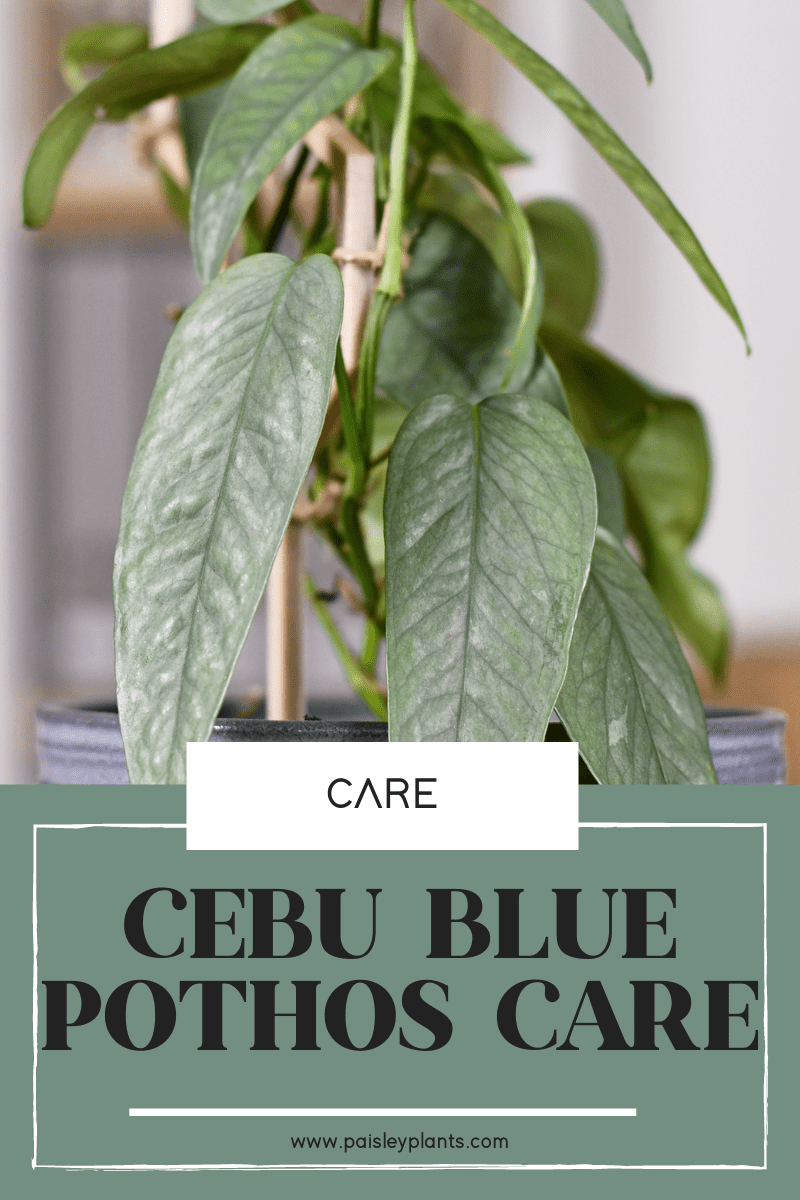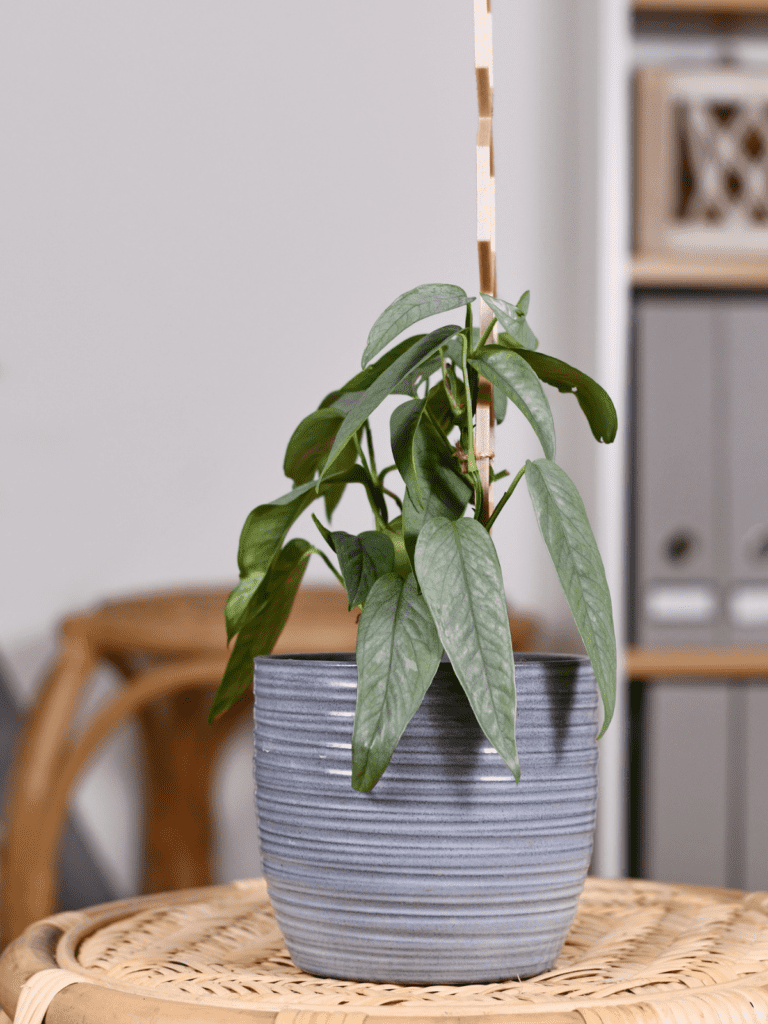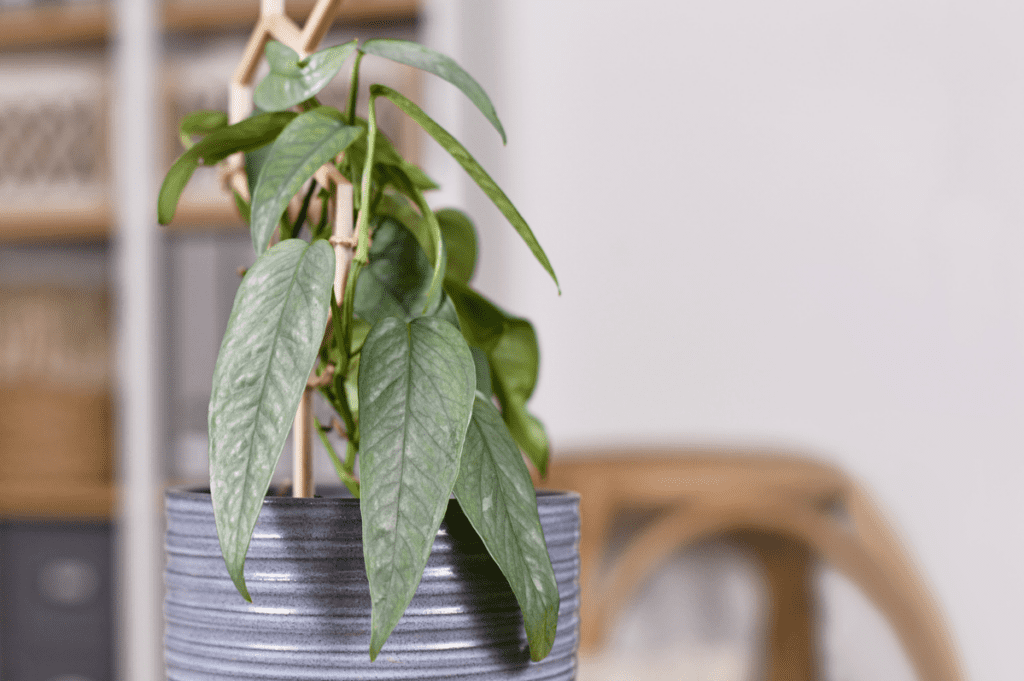Are you looking for a fun twist on a classic pothos? Then look no further than the Cebu blue pothos. This sought-after variety of pothos is exciting and exotic.
But it’s more than just its beautiful foliage, it’s also very straightforward and easy to care for. Read on for this ultimate care guide to the Cebu blue pothos.

This post includes affiliate links.
Table of Contents
Cebu Blue Pothos Background
The Cebu blue is a rare variety of the Epipremnum pinnatum, otherwise known as the Cebu Blue. The Cebu blue is native to Cebu Island, Philippines and is most sought-after for its silver-blue foliage.
The common names for the Epipremnum pinnatum is Cebu Blue Pothos (of course), Cebu Blue, Blue Pothos, Dragon tail, Centipedd Tongavine, Devil’s Ivy (although Devil’s Ivy is typically used for Golden and Jade Pothos).
When growing Cebu Blue plants indoors, it’s capable of growing to great lengths; at full maturity, a Cebu blue can reach a length of 8 feet long. This is only a fraction of its size when grown outdoors, which can reach a whopping 40 feet long at maturity!
The Cebu Blue’s growth cycle is separated into two categories; the juvenile and mature phases. When juvenile, the Cebu blue pothos is silvery blue with elongated, oblong shaped leaves.
As it matures, these leaves turn greener in color and the leaves grow larger (though the mature phase is only attainable in outdoor-grown Cebu blues).
Unfortunately for pet owners, the pothos Cebu blue is toxic to both cats and dogs, like all the other members of the pothos group. If you do plan on owning this plant, it is recommended to exercise extreme caution in keeping this out of reach from your furry friends.
Cebu Blue Care
While the Cebu blue is certainly a unique plant, Cebu Blue pothos care is just as easy and straightforward as any other pothos! Follow these growing preferences to ensure a happy, healthy plant.
Sun & Light
The Cebu blue should receive medium to bright indirect light to ensure to a healthy growth pattern. This particular variety of pothos does not fare well in low light conditions.
At the same time, it is equally as important not to allow your cebu blue to sit in direct sunlight, as this can cause the leaves to burn.
Soil Type
The Cebu blue is similar to all other members of the pothos group; they enjoy a moist, well-draining soil with a pH level around 6.1 to 7.8. You can mix your own potting mix at home using one part perlite, one part potting soil, and one part orchid bark.
Water
While the Cebu Blue enjoys a moist soil, it is just as important to ensure that your cebut blue is not overwatered. You can prevent overwatering by refraining from watering your plant until the first 1 to 2 inches of soil have dried up.
While the Cebu blue is capable of withstanding slightly droughty conditions, it grows best when it is watered on a regular schedule. During the winter months when your plant is in its dormant period, it is a good idea to cut back on watering your plant.
Fertilizer
Applying a fertilizer routine to your cebu blue’s care is helpful in encouraging strong foliage growth. Once a month during the spring & summer, apply a balanced liquid fertilizer to your plant.
Cease fertilizing entirely during the fall & winter when your plant enters its dormant period.
Temperature & Humidity
Despite being native to the tropical regions of the Philippines, the Cebu blue pothos is surprisingly tolerant of home conditions. The ideal temperature range for this particular plant is somewhere between 60° and 80° F, which is more than attainable inside of the household.
The Cebu blue also enjoys humid air conditions. If possible, try placing your plant in a location of the house that receives the most amount of humidity (kitchen or bathroom). You can also increase the humidity of your home by purchasing an air humidifier.
Choosing a Container & Repotting

When selecting a container to house your Cebu blue pothos in, it is extremely crucial to make sure that the planter has adequate drainage holes. Without drainage holes, your Cebu Blue runs the risk of contracting a nasty fungal infection.
The Cebu blue pothos is a perfect plant to house in a hanging basket, though it will do well in a regular plant pot as well. Select a plant pot that is slightly larger than the size of the root ball, about 2 inches larger in height and diameter.
Cebu blues thrive when their owners frequently repot them. You will know your Cebu blue needs to be repotted when the leaves begin to split apart. Repot them in a planter that is a few inches larger than the previous.
How to Prune Pothos
Pruning your Cebu Blue not only helps retain its appearance by encouraging healthy growth, but you can also prune your pothos to control its size if it’s getting too long for your liking.
As always, please remember to properly sterilize any pruning equipment with rubbing alcohol to prevent the spread of infection.
Remove any dead or damaged foliage from your plant; this will help redirect your plant’s energy towards creating new leaf growth, rather than trying to revive dead foliage.
What can you do with the healthy cuttings that you remove from your plant? You can always propagate Cebu Blue plants to create more plants, or even to make a bushier plant. Read on to our next section to find out more.
Propagating Cebu Blue
Like all other pothos plants, the Cebu blue can easily be propagated via stem cuttings. Using these cuttings, you’re duplicating your plant. Many pothos owners use propagation as a way to make their original plant appear fuller and bushier.
You can also create an entirely new debu blue plant that you can gift to loved ones. The best part is how easy and fun propagation is.
Follow these steps for propagating your Cebu blue pothos:
- Take a healthy stem cutting from your mature cebu blue. Please make sure there are at least a few leaves on the cutting.
- Remove the bottom 2 or 3 leaves from the stem. This will expose the node and increase the odds of rooting. You also want to make sure no leaves are submerged in the water.
- Place the stem cutting in a small jar or propagation station of water. Make sure that the leaves are above the rim of the jar to promote airflow.
- Once a week, switch out the water in the jar to prevent bacteria build-up.
- It takes roughly 2 to 3 weeks for the roots to begin growing. Roots should be at least 1 to 2 inches long before you remove the cuttings from the jar.
- Transfer your cutting into a small jar filled with soil. Make sure to keep the soil moist for the next couple weeks to prevent transplant shock. Once your plant has established its roots in the soil, you may resume to care for it as you would with a regular Cebu blue.
*Find propagation stations here!
Pests
The cebu blue is susceptible to common pests that tend to attack many varieties of houseplant. Namely, two examples of these pests include mealybugs and scale.
Both pests are sap-suckers, meaning that they latch onto your plant’s foliage and suck out the nutrients from your plant. If you don’t physically see these pests on your plant, then you will certainly notice the sticky residue left behind by them.
While mealybugs and scale are extreme nuisances in the garden, they are very easy to be dealt with. Both pests can be eliminated by treating your plant with neem oil or any natural insecticide. Make sure to prune any damaged or dead foliage caused by these insects.
Common Cebu Blue Pothos Problems

While the Cebu blue pothos is not prone to any specific diseases, there are some common problems associated with improper care. Let’s take a look at some examples of problems associated with this plant:
Slow Growth
Slow growth is often associated with a lack of adequate light. Please remember that the Cebu blue pothos’ growth pattern is dependent on a medium to bright indirect light source. Light is crucial to encouraging vigorous growth for your plant.
Wilted Leaves
Wilted leaves or curled leaves are a telltale sign of an under-watered plant. Your plant should return to its normal state a few hours after giving it water.
Please keep in mind that while the Cebu blue pothos is capable of withstanding droughty conditions, this should not be a permanent state of being. Always ensure your plant’s soil is slightly moistened.
Yellow Leaves
This problem is a little hard to pinpoint, as it can be the result of many issues. Some possible causes for yellowing leaves include too much light, not enough water, and inadequate humidity levels.
I recommend taking a look at your plant and its surroundings to deduce what the root cause might be.
Where to Buy a Cebu Blue Pothos Plant
There are a few places I recommend purchasing a Cebu Blue. Obviously your local nursery is the best option so you can pick your perfect plant. However, this isn’t always an option if you don’t have a nursery near you or they don’t carry a Cebu Blue. If that’s the case, Etsy and Amazon are both great options!
With the Cebu blue, you can own a little piece of the tropics in the comfort of your home. I highly recommend a Cebu blue to new indoor gardeners looking to branch out into fun and exciting varieties of classic plants.
The best part about owning a Cebu blue is how easy, fun, and rewarding it is to care for it!

